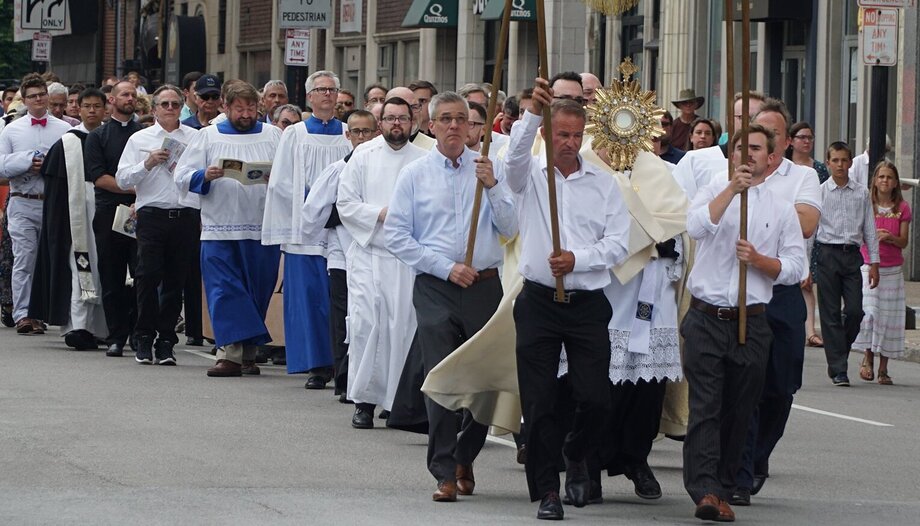Today is the feast of Corpus Christi, a centuries-old tradition in the Church that arose at a time of Eucharistic renewal with the desire to rediscover the importance of the Eucharist and faith in transubstantiation, the transformation of bread and wine into the Body and Blood of Christ at the moment of consecration.
It is an essential event in the life of the Church, a sacrament instituted by Jesus Christ at the Last Supper with the mandate that the Church continue to celebrate it. In the words of St. John Paul II, "the Church lives by the Eucharist" (from the encyclical Ecclesia de Eucharistia, n. 1).
Corpus Christi is traditionally celebrated on the Thursday after Holy Trinity Sunday, although the celebration is usually extended to the following Sunday.
Origin of Corpus Christi
The feast of Corpus Christi has its origins in the Middle Ages and was first celebrated in the 13th century in the diocese of Liège, located in Belgium, specifically in the year 1246.
Among other Eucharistic miracles, the one of Bolsena (Italy) took place at that time, in which a consecrated Host began to bleed while a priest who doubted the real presence of Christ in the Eucharist was celebrating Mass. The peculiarity of this miracle is that, besides being inspected by the Pope, the sacramental species were also inspected by St. Thomas Aquinas, as indicated in the eucharistic miracles website of Blessed Carlo Acutis.
The priest was Peter of Prague, who went to Italy to request an audience with the Pope. He was in Orvieto with some cardinals and theologians, among them St. Thomas. On his return to Bohemia, Peter of Prague celebrated Mass in a church in Bolsena, where the miracle occurred. After approving its authenticity, the Pope decided to institute the feast of Corpus Christi for the whole Church, not just the diocese of Liège, by means of the bull Transiturus de hoc mundo ad Patremin the year 1264. In addition, he commissioned St. Thomas to create the liturgy and hymns to Jesus in the Blessed Sacrament.
From the 14th century onwards, the tradition of the Corpus Christi was strengthened, and another element was added: the processions, which were instituted by Pope John XXII in 1317. These processions had specific rules, although they did not yet include the procession with the consecrated Host. It was in 1447 when Pope Nicholas V introduced the procession through the streets of Rome with the Eucharist.
In Spain, the feast of Corpus Christi began at the beginning of the 14th century. Some documents are preserved that speak of the first celebrations and how the procession was carried out. For example, there is a text by Abbot Alonso Sánchez Gordillo (1561-1644), from 1612, which tells how the procession with the monstrance was carried in Seville: "the monstrance was carried, because of its great weight, by twelve men [...] who were dressed in colored linen clothes, and they were placed under the cover of the platforms" (University of Almeria).
The procession and the monstrances
As it became a traditional and popular festival, the religious celebration of Corpus Christi was also gradually sprinkled with profane elements: "dances, theatrical performances, profane music, giants, big-heads and mojarrillas - who amused the people with the noise of bladders swollen with pebbles" (explains the University of Almeria). Of special relevance was the tarasca, a representation of a giant snake that used to lead the parade.

Faced with the protests of some bishops, Charles III prohibited the dances, gigantones and other profane manifestations that accompanied the procession in 1777 and in 1780.
Today, some of the processions preserve their ancient route, as is the case of Seville: the route that the procession would follow through the streets was established in 1532 and is the same as the one that takes place today.
Another important element of this celebration are the monstrances, which are usually valuable and very ornate objects. When the tradition of the processional procession began, the Eucharist was carried in an ark, and it was not until 1587 when the monstrance began to be used to go out into the streets.
Some of those used in our time are very old. The monstrance preserved in the cathedral of Toledo and used for the procession of the Corpus dates from the 16th century and was made by the silversmith Enrique de Arda; the one in the cathedral of Seville is by Juan de Arfe Villafañe, also from the 16th century. For its part, the cathedral of Valencia has the largest monstrance in the world, with six hundred kilos of silver and five kilos of gold, as well as precious stones and pearls.
Popular traditions
The feast of Corpus Christi is also punctuated by local folk traditions in almost all regions of the world. In Peru the procession is accompanied by traditional dances such as the Danza de los Negritos, the Voladores de Papantla or the Quetzales.
In Mexico there is a tradition of giving mules as a gift, due to an old story that tells that the mule of a man who was considering a priestly vocation knelt down when the monstrance with the Eucharist passed by.
Meanwhile, in some regions of Panama, especially in La Villa de los Santos and Parita, there is the custom of dressing up as demons, who dance during the procession and end up surrendering to Christ the Eucharist and taking off their masks. These dances have been declared Intangible Cultural Heritage of Humanity by UNESCO.
The Eucharist in the life of the Church
All these manifestations highlight the importance of the Eucharist on this day. In the encyclical of St. John Paul II cited above, Ecclesia de EucharistiaRecalling the institution of this sacrament by Jesus Christ, the Pope asks: "Did the Apostles who participated in the Last Supper understand the meaning of the words that came from the lips of Christ? Perhaps not. Those words would have been fully clarified only at the end of the Triduum sacrum(...) From the paschal mystery the Church is born.
Precisely for this reason the Eucharist, which is the sacrament par excellence of the paschal mystery, is at the center of ecclesiastical life. This can be seen already from the first images of the Church offered to us in the Acts of the Apostles: 'They devoted themselves to the apostles' teaching and fellowship, to the breaking of bread and the prayers' (2:42). (...) After two thousand years we continue to reproduce that primordial image of the Church".
The Eucharist, in short, fulfills one of Christ's last promises before the Ascension: "And know that I am with you always, to the end of the age" (Mt 28:20).








